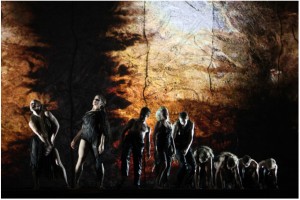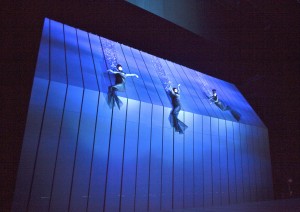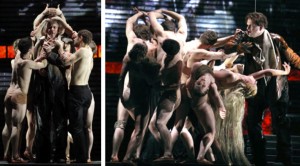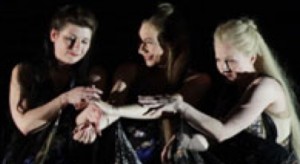To paraphrase an infamous quote of one of our late presidents, “You seen one Das Rheingold, you seen Ďem all.”¬† Right?¬† Wrong!¬†
Last night, November 22, 2010, I attended an Emerging Pictures HD production from La Scala – the third different production I have seen in the past two years.¬† To be sure, the names of the characters and the German words that they sing are all the same – but the interpretation of the characters, the English translation of the words, and the dynamics of the singing can be very different.¬† However, the most striking difference is in the staging.¬† They say, “One picture is worth a thousand words,” so let me illustrate:

In the 2006 Valencia production, which I saw as an Encore in the Emerging Pictures HD series a year and a half ago, the Rheinmaidens sang from tanks of real water, as shown above.
Earlier this fall, I saw the MetHD Live performance where the creased base, the computer generated bubbles, and the lighting combined to give an illusion of being underwater.
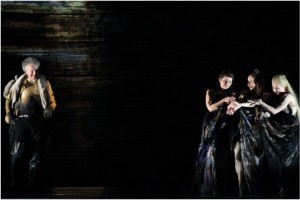
As you can see, the La Scala production gave the merest hint of being underwater.  More was left to our imaginations.
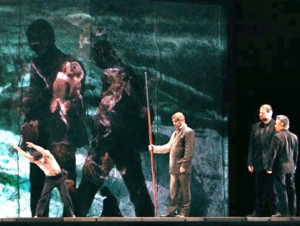
Any producer of Das Rheingold faces the problem of Faffner and Fasolt Рtwo giants with opera-quality bass voices.  There is no satisfactory real solution, so the director must resort to illusion.  At La Scala, Faffner (2nd from right) is slightly taller than Wotan (with the spear), but Fasolt (extreme right) is notably shorter.  However, whenever they appear on stage, two gigantic shadows are projected on the back of the stage to encourage the audience to Think Giant whenever they see Faffner or Fasolt.

The Met’s solution is to always show the Giants at a higher level than the Gods.¬† Thus, if you concentrate on their heads and shoulders, it is easy to believe that Faffner and Fasolt are about twice as tall as Wotan.
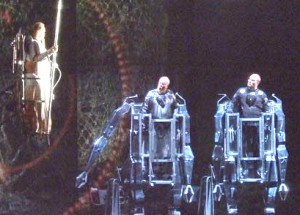
At Valencia, Faffner and Fasolt have human heads but their bodies are giant robots. They are clearly enormous compared to Wotan, even though the latter is at a higher elevation because Gods are a superior race.
The most  unusual feature of the La Scala production was the introduction of a ballet corps.  At times, I thought this was quite effective as above where they represented the magic helmet, Tarnhelm.
However, the purpose of their writhing and posing was not always clear to me and I found their antics more distracting than helpful.
Just before the finale the earth-goddess, Erda, appears out of nowhere to tell Wotan, “Don’t be an utter idiot.¬† Get rid of that cursed ring before it kills you and the whole race of gods.”¬† I don’t recall exactly how this was done at the other two performances – and I don’t have a picture of either.¬† But I’m pretty sure last night was the most dramatic.¬† First her head seemed to rise out of the ground, then her neck, her shoulders, her torso, her skirt, her skirt, her skirt, ….¬† Very impressive.
I depend on the subtitles to follow just what is happening in an opera, particularly one that is as basically static as Das Rheingold, and I seemed to be getting more out of it last night than I remember doing on either of the previous occasions.  I have no way of knowing how much of this was due to a better translation and how much to the fact that I knew more coming in.  But count it as a plus.
You can call me a chauvinist for saying it, but I enjoy looking at attractive women.¬† The Gods are immortal which means they never grow old.¬† But it must also mean that they never were young.¬† Each God or Goddess was, is, and always will be at the proper role for his or her function.¬† Now, judging by their words and actions, the Rheinmaidens are teenagers, and I find that fact easier to believe about La Scala’s trio than about other Rheinmaidens I have seen.
And whereas I wouldn’t say a word against Stephanie Blythe’s magnificent voice, you must admit that Doris Soffel is easier to look at.¬† Female appearance is another plus for La Scala.
So, should you go to see it?¬† The question is probably moot by now, but if you have a chance, I’d say “Yes!”¬† I’ve glanced at a couple of other reviews, and they all agree that the music was good – and on the ballet they vary all the way from “Wow” to “Ugh”.¬† Form your own opinion.¬† In any event, I’m looking forward to seeing what La Scala will do with Die Walkure in January.¬† Find your local theater at emergingpictures.com/opera-in-cinema/theaters/ and treat yourself to an experience.
The Opera Nut
| Performer | |
| Wotan | Ren… Pape |
| Donner | Jan Buchwald |
| Froh | Marco Jentzsch |
| Loge | Stephan Rťľgamer |
| Alberich | Johannes Martin Krť§nzle |
| Mime | Wolfgang Ablinger-Sperracke |
| Fasolt | Kwangchul Youn |
| Fafner | Timo Riihonen |
| Fricka | Doris Soffel |
| Freia | Anna Samuil |
| Erda | Anna Larsson |
| Woglinde | Aga Mikolaj |
| Wellgunde | Maria Gortsevskaya |
| Flosshilde | Marina Prudenskaya |
Photos:
- (LaS) Marco Brescia – La Scala Photographic Archives
- (M)  Ken Howard or Marty Sohl/Metropolitan Opera
- (V)  Various sources on the web
This review by Philip G Hodge appeared in sanfranciscosplash.com on November 26, 2010.

